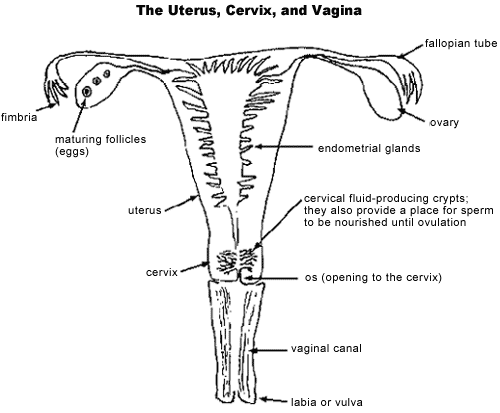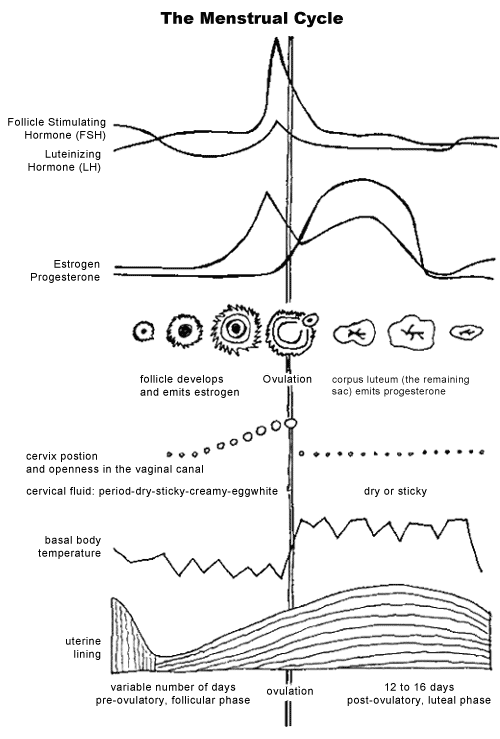 |
|
|
|
|
R E P R O D U C T I V E A N A T O M Y (Please note: This section absolutely does not include the rules for preventing pregnancy by Fertility Awareness.) THE FEMALE REPRODUCTIVE SYSTEM The female reproductive system operates in a cyclical rhythm. Until puberty, a girl is not fertile. Once she begins to menstruate, she continues to be fertile until menopause. Unlike most species on the planet, a woman can live for decades after her biological fertility has ended. During the childbearing years, each cycle moves the woman through infertile, fertile, and again infertile phases. The female reproductive organs: The uterus is a sterile muscle, shaped like an upside-down pear. (There are no bacteria in the uterus so that it can provide a hospitable environment for a baby. Its sterility also means it has no bacteria for fighting infection). The small end of the uterus is called the cervix, and it rests at the top of the vaginal canal. The opening of the cervix is called the os. It’s what dilates ten centimeters during childbirth. Menstrual blood also passes through the os; and the os is what gets swabbed during a pap smear to test for cervical cancer. Fertility Awareness teachers call the cervix The Sperm Hotel because it has little tributary-like glands, called crypts, which produce cervical fluid (CF); and inside the crypts’ recesses, cervical fluid can keep sperm alive for up to five days. Cervical fluid is also called cervical mucus. It also filters out impaired sperm, and it provides a conduit for sperm to travel from the cervix to the outer edge of the fallopian tube at ovulation. On each side of the top of the uterus, there are two appendages: an ovary and a fallopian tube. At birth, a baby girl’s ovaries hold about one million follicles. A follicle is an unripe egg held in a sac. All of these follicles are produced by the time the fetus is just four months old! The lips to the vagina are called the labia or the vulva.
THE MENSTRUAL CYCLE At puberty, a girl’s menstrual cycles and fertility are activated. At the beginning of a cycle, the pituitary gland sends a message to one of the ovaries to begin developing follicles. Hormones carry messages through the blood. Follicle Stimulating Hormone (FSH) begins the cycle by activating follicles (in just one ovary) toward maturity. By puberty, a little more than half of the girl’s follicles have dissolved. With each new cycle, FSH activates about a dozen follicles to ripen. Once they’ve been stimulated to begin maturing, these follicles produce estrogen. While these follicles are maturing and emitting estrogen, the woman is in her follicular phase. The follicular phase typcially begins just after menstruation, and ends at ovulation. The follicular phase is also called the pre-ovulatory phase. During this part of the cycle, estrogen is dominant. Estrogen has several functions:
When one egg within a follicle reaches maturity (10% of the time, two eggs reach maturity, as in the case of fraternal twins), the brain hears the news. It sends a blast of Luteinizing Hormone (LH) down to the ovary. The ripe egg bursts out of its follicle, and the fimbria (the fingers of the fallopian tube) reach out and grab the egg. This is called ovulation. (Even if two eggs are released over two days, it’s still only one ovulation for the cycle.) A ripe egg can live in the outer edge of a fallopian tube for 12-24 hours. If there are sperm in the woman’s cervix or if the couple has intercourse while an egg is alive in a fallopian tube, the sperm can travel up through the uterus and the fallopian tube and try to fertilize the egg. Fertilizing the egg is called conception. If there are no sperm present in the cervix, and if the woman has no unprotected sexual intercourse while the egg is alive, then the egg will simply die. It’s important to note that being fertile is not the same as ovulating. A woman is fertile when she has cervical fluid that can keep sperm alive; ovulation refers to the 12 - 24 hours that a mature egg is alive in a fallopian tube and capable of being fertilized. Before I describe what happens to a fertilized egg, let’s go back to the follicle, which is now an empty sac, still residing in the ovary. After ovulation, the follicle changes its name and its job. Now it’s called the corpus luteum and it emits progesterone. When I hear “progesterone,” I think pro-gestation. This hormone has several functions.
Progesterone is the dominant hormone during the woman’s luteal phase; this phase is also called the post-ovulatory phase. Healthy progesterone levels may also prevent women from having menstrual cramps, weak libido, and menopausal problems. Progesterone is activated after ovulation whether the woman conceives or not. Typically, the corpus luteum will live and emit progesterone for 11-16 days. If the woman does not become pregnant, the corpus luteum will die, her temperature will drop, and she’ll begin menstruating within a day or two. If there are sperm in the cervix or if the woman has intercourse while the egg is alive at the edge of the fallopian tube, then the sperm will travel to the egg as fast as they can swim. It’s not known how sperm sense that a ripe egg is available, but they can reach it in as little as thirty minutes. We’ve all heard it takes only one sperm to fertilize an egg, but in fact it takes about 200: the egg’s enzymatic shell needs that many to be cracked. The sperm that cracks through the shell first is the one that fertilizes the egg. If the egg is fertilized, it will take about a week to travel down the fallopian tube (which is about three hairs wide), and implant in the uterine lining. When this happens, the woman is pregnant.
Note the difference between conception and pregnancy: conception is what happens when one sperm penetrates the egg in the outer edge of the fallopian tube. When the fertilized egg implants in the uterine lining, that’s pregnancy. If the woman does become pregnant, then the corpus luteum will continue to live and emit progesterone for three months; and then the placenta takes over progesterone production. If the embryo implants in the woman’s uterus, then Human Chorionic Gonodotropin (HCG) will be activated. This hormone is the only one women and men do not have in common. Pregnancy tests are determined by the presence or lack of HCG.
And here’s something about the menstrual cycle which also clarifies the difference between the (ineffective) Rhythm Method and Fertility Awareness: In the 30s, a surgeon in Japan and one in Austria discovered, independently of each other, that a woman typically begins menstruating fourteen days after she ovulates. In other words, the luteal (post-ovulatory) phase is usually about two weeks long. With this information, a mathematical formula was created to calculate when a woman was fertile—based on her past cycles. This Rhythm Method proved ineffective because most women’s cycles are not predictable or consistent. For example, if a woman ovulates on Day 8 of her cycle and has a healthy 13-day luteal phase—her whole cycle would last 21 days (three weeks). A few cycles later, she might ovulate on Day 18 and have a 14-day luteal phase: this cycle would last 32 days (four and a half weeks). Some women have a pre-ovulatory phase which lasts for several months; then they ovulate and begin bleeding about two weeks after ovulation. In all of these cases, charting fertility signals allows women to discern when they’re fertile and not fertile. The Rhythm Method’s calculations would not help. Indeed, the follicular, pre-ovulatory phase is unpredictable. The luteal, post-ovulatory phase is more predictable; but it can still vary from cycle to cycle—though it wouldn’t last longer than 16 days unless the woman is pregnant. Many factors can affect the regularity of a woman’s cycles: illness, travel, diet, stress, or lifecycle changes. A woman can observe her primary fertility signals: her waking temperature, cervical fluid, and cervix changes. When these signals are charted every day and the woman knows how to interpret her charts, she can determine when she is fertile and not fertile, and she can use the charts to help gauge her gynecological health. Click here to see photographs that illustrate changes in the cervixes and cervical fluid of several women during their menstrual cycles.
|
|
|
|
Katie Singer, P.O. Box 6574, Santa Fe, New Mexico 87502 Copyright © 2002-2007 Katie Singer · All rights reserved Disclaimer |





